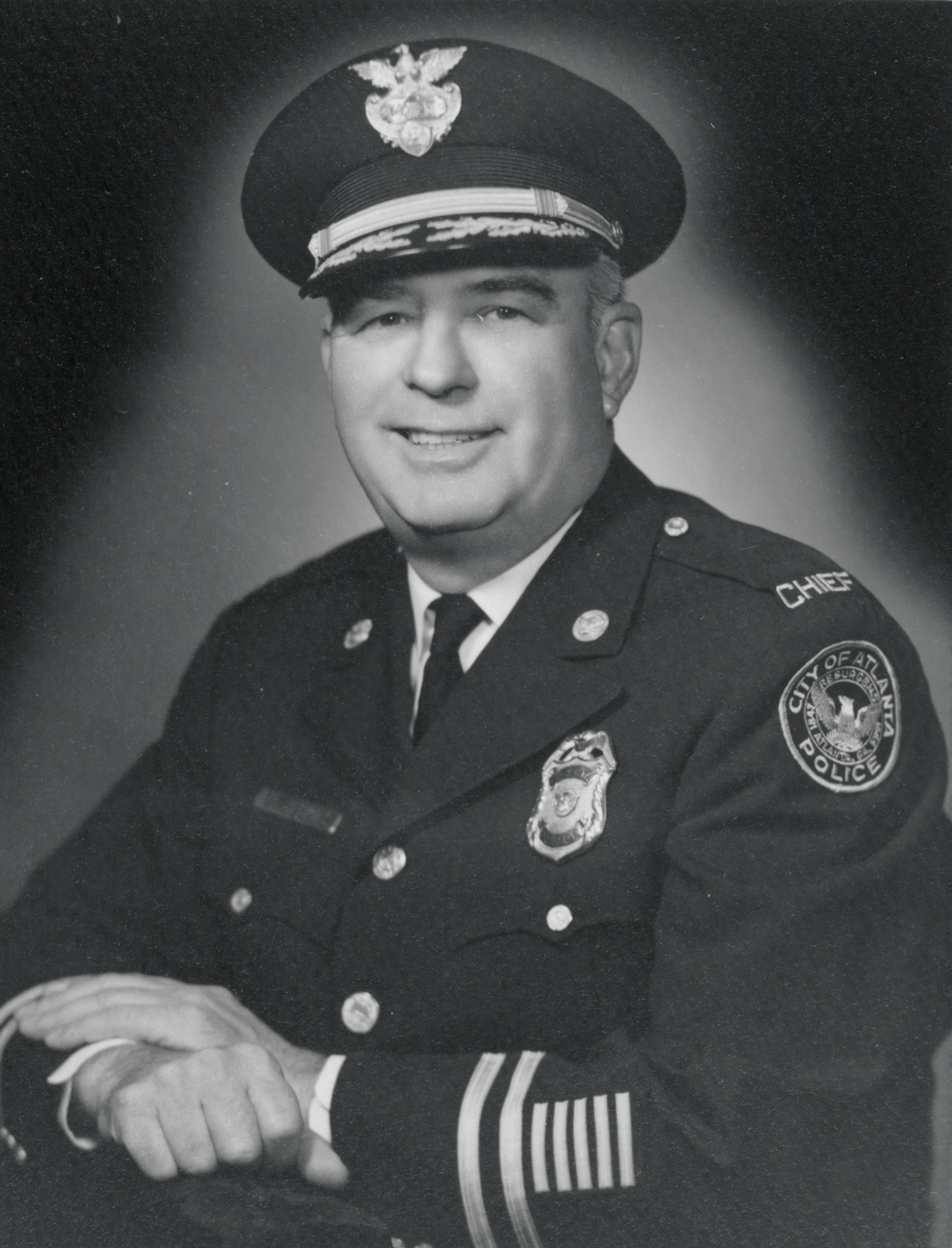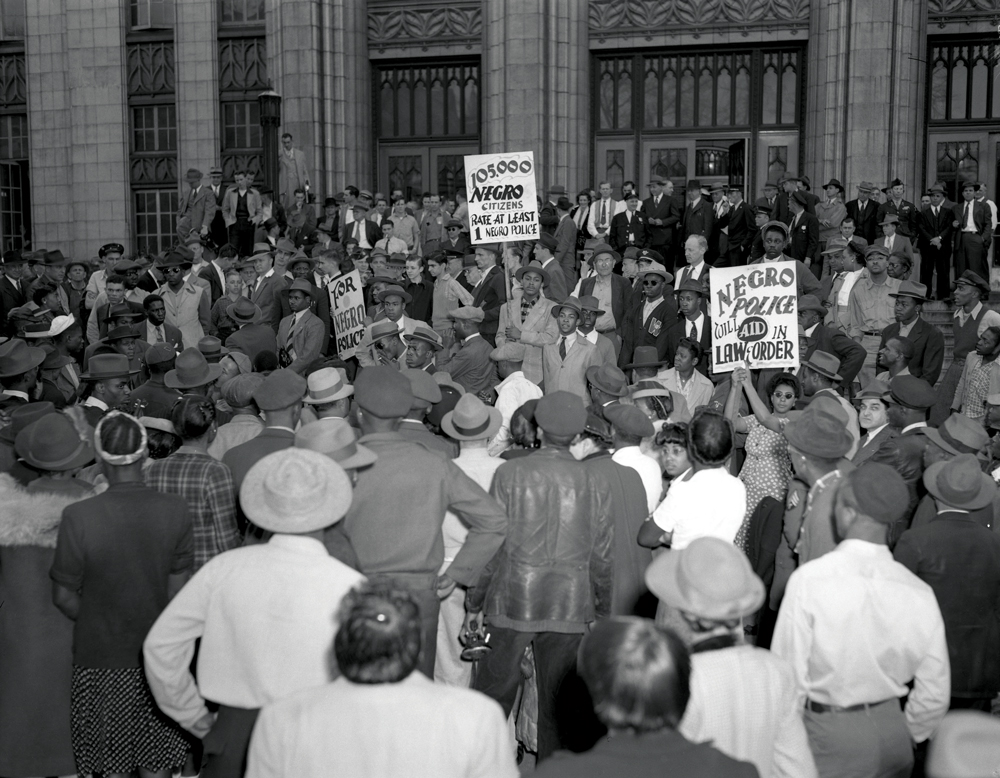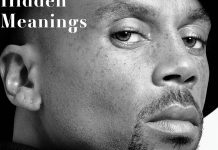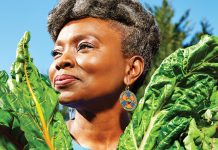
Photograph courtesy of Kenan Research Center at the Atlanta History Center
By the mid-1900s, the Butler Street YMCA had earned the nickname “black city hall.” Situated in Sweet Auburn, then Atlanta’s most vibrant and commercially successful black neighborhood, the Y functioned not just as a gym and rooming house but as a favored meeting place for political discussions among the city’s black leaders and as the de facto headquarters of the Atlanta Negro Voters League.
On April 3, 1948, the Y took on yet another role: Its basement became a police precinct.
That afternoon, Mayor William Hartsfield and Police Chief Herbert Jenkins, both white, stood before Atlanta’s first eight African American police officers as they prepared for active duty. They ranged in age from 21 to 32. All but one were World War II veterans. Hartsfield gave a rallying speech, warning that though 95 percent of the white cops didn’t want them, they were here to do what Jackie Robinson had done for baseball the year before.
When the officers stepped outside, they faced a festive crowd of 400. An elderly woman handed them flowers. They split into pairs and began walking their beats, and many in the crowd followed them, an impromptu parade down Auburn Avenue. One of the officers, Ernest Lyons, later said he felt like a god.
Despite Hartsfield’s encouraging comparison to Jackie Robinson, the Atlanta Police Department technically wasn’t being integrated at all. The reason a YMCA basement served as their precinct was because they weren’t allowed to use police headquarters. Hartsfield and Jenkins were afraid that white cops, many of them Klansmen, would riot at the mere sight of them. (Bear in mind that, back then, the phrase race riot had usually meant white people attacking nonwhites.)
The new black officers also were not permitted to drive squad cars, patrol white neighborhoods, or wear their uniforms to or from work, and they absolutely could not arrest white people.
I learned of these officers when I read former Atlanta Journal-Constitution reporter Gary Pomerantz’s 1996 history of Atlanta, Where Peachtree Meets Sweet Auburn. He devotes just four pages of his 545-page epic to the city’s first black cops, whose swearing-in prefaced the coming victories of the civil rights movement. But I wanted to know more. As black people in the Jim Crow South, they were second-class citizens, barred from the front of buses, most restaurants, and public parks, and constantly at risk of state-sanctioned or mob-rule violence. Yet they were also authority figures, charged with enforcing laws that often oppressed them and their families.
“Let me tell you, it was not easy for me to raise my right hand and say, ‘I, Willard Strickland, a Negro, do solemnly swear to perform the duties of a Negro Policeman,’” one of the barrier-breaking rookies noted in a speech years later.
What was it like to inhabit this strange dual role? As a novelist, I’m always on the lookout for remarkable stories, distinctive settings, and characters whose struggles reflect a larger social conflict, and I felt that I had stumbled upon the makings of a fascinating mystery novel. (You can read an excerpt of my novel, Darktown, at the end of this article.)
It was fortuitous timing, as I had been interested in delving into Southern history. Although born and raised in Rhode Island, I’ve lived south of the Mason-Dixon for 16 years. Back in 2008, my wife and I moved from Washington, D.C., to Decatur. Like many transplants, we had come for a combination of affordability, work opportunities, family (my in-laws live in Gwinnett), and fabulous weather.
Still, moving had been a long and difficult decision. One thing I had not thought about during our deliberations, though, was what the move meant for me as a writer. I can live as a writer anywhere, I’d figured. It doesn’t matter. A month later, standing among the shelves of A Cappella Books near Little Five Points, I saw an entire section dedicated to “Southern writers” and worried for the first time whether I belonged. I had lived and worked in the South for years, sure, but my first three books were set in Washington State, Ohio, and Washington, D.C.
A marketing executive or IT programmer who relocates to Atlanta probably doesn’t wrestle with whether they’ll be considered a Southern marketing exec or a Southern programmer. Yet as a writer it felt freighted with meaning. There was a club, with a long and esteemed lineage from Flannery O’Connor, Robert Penn Warren, and Zora Neale Hurston to Pat Conroy, Alice Walker, and Charles Frazier, and I was wearing the wrong baseball cap. Still, I quickly came to love living in Atlanta, raising boys who get orange clay stains on their clothes, watching the sunset from our porch on impossibly hot nights, and connecting with other writers and artists in this vibrantly creative community.
Then, in the summer of 2012, I read Pomerantz’s book and discovered the story of Atlanta’s first black cops. This was before the shooting of Michael Brown in Ferguson, the death of Freddie Gray in Baltimore, and so many related tragedies, from Staten Island to Cleveland to Baton Rouge to Dallas, that thrust the issue of race and policing into the national spotlight. Yet it was already a time of George Zimmerman and Trayvon Martin, a time of dog-whistle criticism of our nation’s first black president. My past work has wrestled with what it means to be American and how the various tangled threads of our past have combined to weave us into who we are today. To write about American identity in the South means writing about race.
I began tracking down out-of-print books and combing through Emory University’s digital archives of the Atlanta Daily World, which—as the city’s oldest black newspaper—covered the story closely. At the Auburn Avenue Research Library, I found Officer Strickland’s hand-written speech. At the Atlanta History Center, I listened to recorded 1979 interviews with some of the original (all now deceased) officers themselves.

Photograph by Atlanta Journal-Constitution via AP
The story begins more than a decade before that historic day in 1948. As early as the 1930s, black community leaders were asking for black officers. Not only would black policemen break a racial barrier, leaders argued, but their inherent understanding of the black community and the problems its citizens faced would help them police the neighbors better than white cops did.
The mayor at the time, James L. Key, refused, but he later took aside young Herbert Jenkins, then an officer assigned as Key’s driver, and predicted that the force would integrate within Jenkins’s lifetime.

Photograph courtesy of Kenan Research Center at the Atlanta History Center
This was impossible for Jenkins to imagine, considering that an estimated quarter of Atlanta cops, including Jenkins, owned a second uniform: the white robe of the Ku Klux Klan. The police union itself was a thinly veiled cover for the Klan.
Not surprisingly, white officers were routinely accused of brutality against black people. Late one August night in 1940, a white woman, Marian Doom, heard the sounds of a struggle outside her apartment at 1302 West Peachtree Street. She called the police and then stepped outside, where she saw a black man she recognized as Earl Sands, a 22-year-old janitor who lived and worked nearby. He was “a little man,” according to a statement she gave. He was being beaten by two men who she soon realized were cops.
According to another witness, the officers repeatedly struck Sands with a blackjack and also wrapped a chain around his neck, dragging him by it to the squad car. A second witness also claimed the officers slammed their car door on Sands’s legs with near bone-breaking force. “They decided they were going to have some fun with him,” said Doom, a 29-year-old bookkeeper. “They just beat him unmercifully, for nothing.” She went back inside to call the police a second time, and the officer who answered laughed at her.
After the assault, Sands was charged with drunkenness and resisting arrest, and fined $34.
The incident may well have gone unreported if not for Doom and a large number of other outraged witnesses. One of them, William C. Henson, was also an attorney, and later that week he filed a warrant in Fulton County court charging one of the cops, patrolman G.S. Robertson, with assault and battery. “This was the most inhuman act of brutality ever witnessed by any man wearing a blue coat,” Henson wrote in a letter to the chairman of the Police Committee. He claimed he had 20 witnesses who agreed.
In his defense, Robertson said that Sands was intoxicated and had attempted to run away, so he and Officer W.E. Whitten had given chase. He stated that Sands had grabbed an iron guard chain that ran along an apartment building’s walkway, and the chain broke and became entwined with Sands during the scuffle.
After a seven-hour hearing, which was page one news in the Atlanta Daily World, Judge Robert Carpenter agreed with the officers. “Being a police officer in Atlanta is no easy job,” he opined.

Photograph by Atlanta Journal-Constitution via AP
The push for black policemen intensified. By 1947 black leaders knew they had a potential ally in new mayor William Hartsfield, who was known for being a moderate, relatively speaking, on “the race issue.” He’d even been photographed shaking black people’s hands, a risky move at the time. But Hartsfield was a consummate politician. Three years before, the Supreme Court had ruled that the all-white primaries, which had shut black people out of elections across the Jim Crow South, were unconstitutional. The impact of that decision was monumental: Black community leaders spearheaded a massive registration effort, adding nearly 18,000 black voters to the rolls. Here were voters who could help Hartsfield win reelection.
Hartsfield discussed the matter with Chief Jenkins and black leaders, including the Reverend Martin Luther King Sr., Morehouse College President B.E. Mays, and C.A. Scott, editor and owner of the Atlanta Daily World. By then 44 other Southern cities—including Miami, Charlotte, Raleigh, and Durham—had integrated their police forces. Armed with testimony from officials in those cities, they made a savvy appeal to Atlanta’s exalted sense of pride. Shouldn’t we be leading the charge, rather than falling behind? Even Chief Jenkins, a former Klansman, saw the logic in such a move. (He would later claim his youthful Klan initiation had merely been a formality necessary for promotion within the department.)
At a “heated, rip-roaring” hearing before the Police Committee of the Atlanta City Council, opponents argued that foolish politicians were bowing down before “the bloc vote of the Negro,” while the Reverend King countered that “the time and the hour” had arrived for the council to “give the Negro a chance.” Five days later, the headline “COUNCIL, HARTSFIELD GIVE OKAY TO NEGRO POLICE” ran across every column on the Daily World’s front page.
Who were the brave torchbearers? Ernest H. Lyons had wanted to be a cop since he was seven, when he saw a man chase down a woman and stab her, and wondered why no police had arrived to help. John H. Sanders was a former salutatorian of Booker T. Washington High School, but the only work he could find was as a janitor. They and six others—Claude Dixon, Willie T. Elkins, Johnnie P. Jones, Henry Hooks, Robert McKibbens, and Willard Strickland—were sworn in on March 8, 1948, and began active duty April 3.
They were derisively called “YMCA cops” by some black people who resented their authority. Lyons estimated that a quarter of Atlanta’s black population didn’t want them, and another quarter would accept them only “as long as we didn’t arrest them.”
That was nothing compared to the reaction of white cops. They falsely reported the black officers for drinking (consumption of alcohol was forbidden for policemen) and routinely tried to run over black cops as they crossed the street. One brazen white officer even offered a $200 bounty to anyone who would kill a black cop.
“We had to fight those we arrested and fight the rest of the force as well,” explained Clarence Perry, who was hired in 1950. “It was us against the world.”
The constant harassment, Jim Crow restrictions, and hypocrisy were too much for some. Elkins resigned on June 16, 1948, just a couple of months into the job. Sanders also quit within a year. Those who continued to serve “each had an inner strength,” said attorney Larry Dingle, who became an Atlanta police officer in 1969 and worked with four of the original eight.
Some of their first jobs involved cracking down on bootleggers who brought illegal whiskey into the black community and arresting drunks who hit wine houses in the morning and would be staggering across the street by afternoon. One day they handed out 75 jaywalking tickets—so many that the drunks started telling each other where best to cross.
The officers made a point of getting to know the people they served. Sometimes they talked grocery stores into selling food to hungry families at a discount. “By going in, not with a blackjack in your hand or a .38, but by trying to talk to people, just sitting down and listening—that’s something no one else had tried before,” McKibbens said in the 1979 interview. It was community policing before the term was invented.
The cops lived in the same neighborhoods they policed. But the community focus was also partly due to the tight restrictions imposed on them. Since they weren’t allowed to drive squad cars, for example, they found themselves face-to-face with citizens.
McKibbens saw how powerful it was simply to call a black woman “ma’am” or a black man “sir.” And Dingle noted that community policing was the best way to develop trust, to show that police—some police, at least—could be relied on to help.
One of the originals, Lyons, often told young officers that their gun was the least important tool in their belt, and that they needed to get to know the people they served and protected. One of Dingle’s first assignments in August 1969 was driving with Lyons in a car equipped with a record player and speakers. They would open fire hydrants, hook up sprinklers, and play James Brown records. “There wasn’t a more decent human being in the Atlanta Police Department than Lyons,” Dingle said.
It wasn’t until 1953 that the city finally closed the Auburn Avenue precinct and allowed black officers to use the main headquarters, though here, too, they were initially confined to the basement. The city didn’t promote a black officer until 1961, when Howard Baugh got the nod (he would go on to retire a major). On that same day, Eldrin Bell, who 13 years earlier had watched the officers’ first day as a schoolboy, joined the force himself. (He rose through the ranks and became police chief in 1990.) Bell was shocked to find that, years after civil rights victories like the Montgomery Bus Boycott, Atlanta’s black cops were still treated as second class. “There was no written rule that we could not arrest white citizens,” he told me. “We were told that. By the [older] black officers.” During his first arrest of a white man, he had to call white officers to actually make the arrest. “I was infuriated,” he said.

Photograph by Atlanta Journal-Constitution via AP
In January 1961, two months before Bell donned his badge, Officer Claude Mundy—who’d been the 12th black cop hired, in 1950—was shot and killed in the line of duty. That tragedy finally caused some white officers to appreciate the sacrifice their black colleagues were making. “Before it was like we were getting something we hadn’t earned,” explained Baugh. “But when he shed his blood, it was like: They’re here.”
The following year, Chief Jenkins formally allowed black cops to arrest white perpetrators. And as the black community grew, white detectives frequently needed black officers’ help finding suspects or witnesses. Still, when Dingle started in 1969, it was still rare for a black officer to be assigned to a nonblack area. Caesar Mitchell Sr.—who joined the force in the 1960s and is the father of current Atlanta City Council President Ceasar C. Mitchell—and another officer, Floyd Reeves, founded the Afro-American Patrolmen’s League, which advocated racial equity in promotions and assignments for officers. Mitchell Sr.’s outspokenness would sometimes earn him unsavory assignments like jail duty or foot patrols in dangerous areas. “He took that and turned it into something beautiful,” his son told me, using the opportunity to get to know his community better. Decades later, the younger Mitchell wrote legislation mandating that new officers walk a certain amount of foot patrols to maintain their connection to the community.
When I started my research, I’d initially hoped I might stumble upon some amazing crime the officers had solved, some scandalous murder investigation I could use for a true crime book. I didn’t find one. Those eight men were barely given the opportunity to become beat cops, much less homicide detectives. But they were pioneers who were issued badges and guns to enforce the laws justly in their own communities. They really did weather death threats from their fellow officers. They walked streets that white officers had seldom ventured down, and they brought community policing to Atlanta. They pushed back at Jim Crow, and they inspired the next generation of cops to push back even harder.
One of the qualities that defines Americans is our unrelenting focus on where we’re going, not where we’re from. The American Dream is that we can have anything if we work hard enough, regardless of the circumstances we were born into. Whether you believe that is truth or myth, you can’t discount the importance of our shared past—the battles we’ve fought, the tragedies we’ve endured, the crimes we’ve committed. I hope Darktown sheds new light on an issue that continues to challenge us, and that readers find inspiration in the silent victories that those eight officers achieved every day they donned their uniforms.
This article originally appeared in our September 2016 issue.














